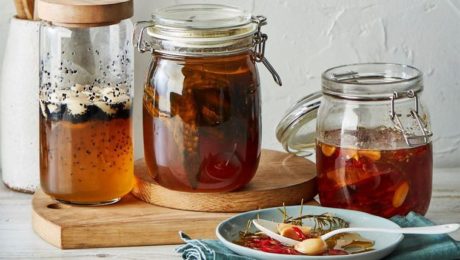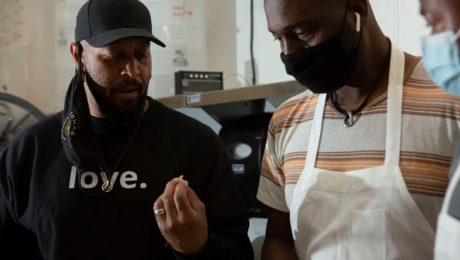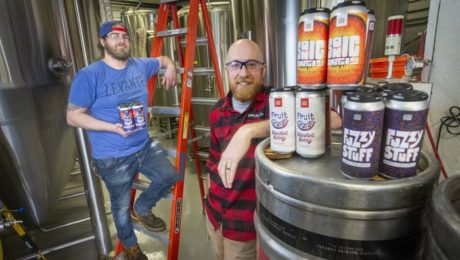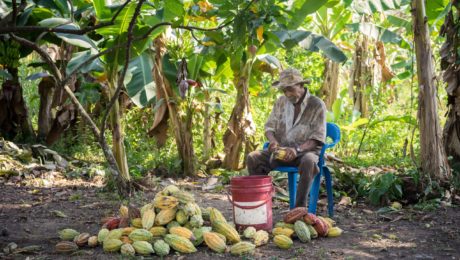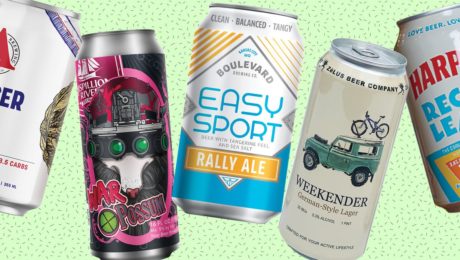Fermented Honey Top Ingredient in 2021
Fermented honey topped the list of emerging ingredients in 2021, as presented by food industry intelligence firm Datassential at the Research Chefs Association’s RCA+ conference. Fermented honey is in the “sweet spot” (pun intended) of intersecting larger trends — consumers gravitating to honey as a sweetener and to fermented products for their health benefits.
Read more (Food Business News)
- Published in Food & Flavor
Hand-Brewed Makgeolli in South Korea
A beautiful new video from Eater shows traditional makgeolli being made by hand in South Korea. Master brewer Park Bok-soon runs Boksoondoga with her son, where they make this milky, slightly sweet, alcoholic fermented rice drink .
Boksoondoga uses nuruk, a fermentation starter, said to help avoid hangover symptoms, such as headache and upset stomach. Nuruk ferments for about 15 days before being mixed with rice, and then ferments for another 20 days or so in onggis, traditional Korean pottery.
“Hand brewed makgeolli is more delicious when you put your heart into it so that’s how I started making my makgeolli business,” Bok-soon says. “Alcohol is like a drink with living organisms. I love it.”
Read more (Eater)
- Published in Food & Flavor
Vegan Cheese Matures
Vegan cheese makers are “pushing the limits of those fermentations to create … flavors and textures I’d previously thought impossible,” writes The New York Times food columnist Tejal Rao. She says the “new generation” of vegan cheese is surprisingly tastier than the bland, starchy, mass-produced vegan cheese of the early 2000s.
Missing from those first versions of vegan cheese: fermentation, a key to creating flavor. Vegan cheese now is also aged and ripened like dairy cheese to develop flavors and textures.
The microbes used to give cheeses like Gouda and Brie their distinct flavors are also critical. Vegan cheese cultures are now readily available. Aaron Bullock and Ian Marin (pictured), founders of Misha’s Kind Foods, work with proprietary cultures to create cream cheese and ricotta made from cashew milk.
Read more (The New York Times)
- Published in Food & Flavor
The Many Sides of Kefir
When Julie Smolyansky began working at her family’s Lifeway Foods business, her father advised her: “Don’t talk about the bacteria. People in America freak out about the bacteria on their food.” So when Lifeway became the first company in the U.S. to put “probiotic” on a label in 2003, it wasn’t a big surprise when customers began calling, asking for the company’s non-probiotic version of kefir.
Americans have come a long way. Consumers today search for the “live, cultured” label on fermented dairy, and gut health is a critical component of the modern diet. Smolyansky and Raquel Guajardo, author/educator, shared their thoughts on kefir during the TFA webinar The Many Sides of Kefir.
“Fermented foods were not part of the American diet, and the way that kefir and fermented foods in general were used in other parts of the world from Asian to Eastern Europe to even India and Mexico, these cultures all have fermented foods as one of their pillars as their foods sources and their health and wellness cultures,” Smolyansky says. “It wasn’t until immigration from all these other countries that we started talking about kimchi or kefir or lassi or you name your cultured kind of special food.”
In the U.S., the average person consumes 9-10 cups of fermented dairy a year. Contrast that statistic with Europe, where the average consumption is 28 cups a month.
“When you’re born consuming it and you’ve developed that taste palette, then it’s very easy to play in the space and have a diet that’s very rich in probiotics and kefir and all sorts of other fermented foods,” Smolyansky says, adding that the situation is changing in the U.S. Now, “people are hungry for it, they want it, once they learn about it, once they taste it, they fall in love with it, they’re hooked.”
Lifeway’s kefir’s sales have soared. The company was valued at $12 million when Smolyansky took over in 2002 — now it’s valued into the hundreds of millions. And even more customers have found kefir during the COVID-19 pandemic, as they adopt healthier lifestyles.
Guajardo has seen her online classes increase during COVID. The Mexico-based educator co-authored the book “Kombucha, Kefir, and Beyond” with Alex Lewin, TFA advisory board member, who moderated the webinar.
“People say ‘You’re crazy, why do you teach what to do at home what you can buy in the supermarket?’ But my business has been growing that way,” she says, adding that health benefits are the main selling point for her classes. “Why would people buy sauerkraut or kefir if you’re not explaining the benefits?”
Dairy Kefir vs. Water Kefir
Guajardo, who makes both dairy kefir and water kefir (also known as tibicos) stresses that the grains used to make each are “totally different.” Kefir grains are living bacteria and yeast microorganisms clumped together with milk proteins and sugars. They are gelatinous and white, almost like cottage cheese. Water kefir grains are also made from living bacteria and yeast microorganisms, but they’re clumped together with sugar and have a translucent, crystal-like appearance.
“Water kefir” is not the appropriate term, Guajardo and Smolyansky agree, instead calling it by its traditional Mexican name, tibicos. And they feel that using kefir or tibicos grains in coconut or almond milk and calling it kefir is also inappropriate. Smolyansky favors using a description like cultured coconut milk or beverage, but not kefir.
The National Dairy Council and Codex Alimentarius, the international food code, both state kefir is a fermented dairy product made from the milk of a lactating mammal. Smolyansky points to the many peer-reviewed studies on kefir, verifying it is full of probiotics and nutrients. Water kefir and non-dairy kefir have not been studied, and can’t guarantee the same health benefits.
“Just by throwing the name onto anything and just bastardizing the definition, we completely dilute any of the research that’s ever been done [on kefir], it would dilute the history, the folklore. So we are very passionate about protecting the name,” Smolyansky says. “My ancestors made sure that kefir survived for 2,000 years, and it’s critical that we don’t dilute it now that it’s having a moment, now that it’s popular.”
Smolyansky’s family emigrated to the United States from the then Soviet Union in the late ‘70s. Her father, Michael, began Lifeway Foods in Chicago in 1986.
“We have to respect the standards and what these definitions mean or it will be the Wild West and people won’t know what they’re buying,” she adds. She shares the labelling of ice cream as an example — ice cream is considered dairy while non-dairy products have other names, like sorbet, gelato or non-dairy frozen dessert.
Can Kefir Grow Like Yogurt?
Yogurt has paved the way for kefir to expand its consumer base in the U.S. Both are fermented dairy products with tangy tastes. But for kefir to achieve widespread, mainstream adoption like yogurt, significant education is needed. Thousands of peer-reviewed studies prove kefir contains a higher concentration of probiotics than yogurt — and a wider range of beneficial bacteria. For kefir to grow, this message needs to reach consumers.
“It’s a different set of microbes,” Lewin says. “Kefir is fermented with yeast and yogurt isn’t. Kefir has a larger family of microbes.”
Smolyansky is passionate that kefir cannot be compared to the products of the major. yogurt companies.
“The yogurt produced in the United States is so over-produced and so over-pasteurized that there’s practically nothing living in it after it’s been processed,” she says. “It’s one of the biggest problems with yogurt in the U.S.”
Lifeway regularly sends their products to be tested for probiotics, measuring Colony Forming Units (CFUs), the active microorganisms in a food product. Smolyansky says eating probiotics is critical in a germ-phobic, antibody-heavy society, where we’re over-sanitizing due to the coronavirus pandemic.
“If our bodies aren’t fighting an outside kind of pathogen, it starts to fight itself,” she says. “One of the ways to counteract this disruption in our microflora is by the use and the introduction of consistently replenishing microflora including diversity of bacteria, a variety of food sources that offer bacteria, the diversity and kind [of bacteria] is always the king. It makes for great food environments in the gut.”
- Published in Business, Food & Flavor
Retail Sales Trends for Fermented Sauces
Shelf-stable fermented sauces are growing tremendously. In the past year, fermented sauces grew 41%, with sales reaching $275 million. Soy sauce still dominates with 70% of the market share, but sales of both fish sauce and gochujang increased over 50%.
“I think a lot of brands are thinking ‘Are we going to hang onto this new [normal], this new baseline?’ This is a segment of products that’s really having its baseline reset,” says Kevin Snodgrass, solutions architect for SPINS. Snodgrass shared insights in a TFA webinar, Retail Trends for Fermented Sauces. “Brands are going to continue to experience this great growth in the months and years ahead.”
The increase is significant — sales growth in the one year from 2019 to 2020 was 5.7%. This improvement is attributable to multiple trends across the food industry — more people are buying healthy food and cooking at home, the American kitchen is becoming more globalized, and more consumers are embracing the unique flavors of fermented sauces, especially those from Asia.
“It definitely coattails a lot on the acceptance and growth of the fermentation market as a whole,” says Jared Schwartz, a TFA Advisory Board member who moderated the webinar. Schwartz is the founder of fermented sauce producer Poor Devil Pepper Co., and director of operations and quality for Farm Ferments, a facility in Hudson, N.Y., that is home to Hawthorne Valley Farm. “As consumers are becoming more open to reaching for fermented foods, kind of the next step is adding a flavorful, fermented hot sauce.”
Brands Growing, but Room for More
The top 10 selling fermented sauce brands in both natural retail grocers (like Whole Foods) and traditional (MULO) outlets (like Wal-Mart and regional grocery chains) are all experiencing double-digit growth. “That’s a great sign,” Snodgrass notes.
Kikkoman, Bragg, San-J, Coconut Kitchen, Lee Kum Kee and Big Tree are among the top 10 brands in both the natural and MULO channels. Smaller brands like Red Boat, Mother-In-Law’s, Ohsawa and Yamasa thrive in the natural channel,; La Choy, BetterBody Foods and Chung Jung One are strong in MULO.
The category is ripe for continued innovation, Snodgrass says. Smaller brands can emerge, even with competition from larger, established brands, so it can be worthwhile to start a fermented sauce brand.
Label Claims & Consumer Education
SPINS found certain product attributes on fermented sauces help sales.. Certified gluten-free fermented sauces grew 40.8%; USDA organic, up 40% and non-GMO increased 33.8%.
Since many sauces don’t put “fermented” on their label, many consumers may not be aware they are, notes Snodgrass. He says that these products could benefit from using “fermented,” as it would suggest that there may be health benefits to the sauces.
Schwartz agrees. He points out Tabasco as a fermented hot sauce, even though producer McIlhenny Company doesn’t market it as such. Educating the consumer would also help the category. Probiotics are a selling point but they confuse buyers. And there’s a clear difference in health benefits between shelf-stable and refrigerated fermented sauces. Refrigerated sauces may have live, beneficial bacteria; shelf-stable ones are pasteurized, killing any good bacteria in the process.
“At the end of the day, I think it comes down to flavor,” Schwartz says. Fermented sauces are “funky and vinegar-free. It’s got this like natural layers of complexity that you can’t really achieve without fermentation.”
- Published in Business, Food & Flavor
Wild Yeasts & Sour Beer
As sour beer becomes more popular, more producers are foregoing traditional kettle-sourcing processes to inoculate their brews with wild yeasts, often found in unusual places. Pennsylvania-based Levante Brewing Co. has developed a yeast called Philly Sour, which was found on the bark of a dogwood tree in a local cemetery and is now sold worldwide.
“I don’t know if the enthusiasm for hops will ever really wane, but with so many beer options available, there is definitely the space for some breweries to focus more on other ingredients,” said Gerard Olson, owner of Forest & Main Brewing Co. in Ambler, PA. That brewery every spring forages for yeasts from flowers on the property and uses them for that season’s saisons.
The Philadelphia Inquirer calls Philly Sour (and Norwegian yeast called kveik) “beer’s mostly unsung heroes.” The professor who isolated the Philly Sour yeast, “sends students into the neighborhood with Ziploc bags to collect samples, leaves, scrapings from bark, and other materials that might have yeast on them. Those materials are tested for fermentation.”
Read more (The Philadelphia Inquirer)
- Published in Food & Flavor
Ferments from India
Have you heard of idli? This fermented and steamed rice and black lentil cake is one of the most popular breakfasts in India. And now, a chef is trying to make it recognized around the world.
The India Times interviewed M Eniyavan, founder of Mallipoo Idli in Chennai, India. Eniyavan created World Idli Day six years ago. He makes over 2,500 varieties of idli, including a tender coconut idli, pizza idli (sans cheese) and even a chocolate idli.
The long fermentation of rice grits with black lentils creates a delicious flavor and has been lauded as “one of the healthiest breakfasts in India.” It’s often served with chutney and sambar (steamed lentil and vegetables tempered with spices.)
Read more (English version, Tennessee Tribune)
- Published in Food & Flavor
Microbes & Chocolate’s Flavor
Love the rich flavor of chocolate? Thank microbes. Scientists are researching how fermentation affects the flavor of chocolate. An article in Scientific American details how a giant cacao seed pod naturally ferments.
Cacao has a wild fermentation, meaning the farmers who harvest the pods “rely on natural microbes in the environment to create unique, local flavors.” Just as grapes take on regional terroir (the characteristic flavor imparted by a place), “these wild microbes, combined with each farmer’s particular process, confer terroir on beans fermented in each location.” Demand for high-quality cacao beans is growing, and producers who make small-batch chocolate with distinctive flavors also are seeing sales growth.
Read more (Scientific American)
- Published in Food & Flavor, Science
Trends in Pandemic Eating
Consumers increasingly embraced adventurous and healthy food over the last twelve months, but “a big pandemic winner is fermented foods.”
An article from the Associated Press details how, now a year into isolation, people are cooking beyond comfort food. They’re “embracing foods long forgotten or rejected for taste, texture or smell.” Anne Alderete (pictured) details how she is finally enjoying natto (fermented soy beans) after rejecting it for years.
Read more (Associated Press)
- Published in Food & Flavor
New Trend: Performance Beer
Inspired by the beer tents popular at the finish line of high-endurance events like marathons and triathlons, creative breweries are adding electrolytes to beer. They are turning alcohol into a hydrating drink, but still giving drinkers a buzz.
The market is small, constituting just 1% of the craft beer market (and craft is just 13% of the total beer market). But performance beer is selling well with consumers wanting alcohol with fewer calories.
Read more (Bloomberg)
- Published in Food & Flavor

